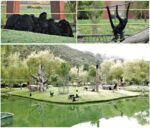Age-sex differences in the social behavior of zoo-housed Colombian black spider monkeys (Ateles fusciceps rufiventris)
Laura Carolina Cortés-Vesga, Andrés LinkSpider monkeys (Ateles spp.) live in multi-male multi-female groups with conspicuous sex differences in ranging patterns, association preferences and social strategies. Behavioral studies in populations under human care can provide a unique opportunity to build on our current understanding of their social behavior. Here, we studied sex differences in social behavior of one group of 18 black spider monkeys (Ateles fusciceps rufiventris) at the Wakatá Biopark, in Colombia. We conducted 20-min focal animal samples, and recorded the focal animal’s activity and the rates and duration of their main social behaviors. Overall, we found no differences between sexes in the time spent in each activity, but adults rested more than juveniles who spent more time socializing. We found behavioral differences between the sexes with males showing a higher frequency of aggressive displays, chest rubbing, tail wrapping, and emitted long distance vocalizations more often than females. Grooming was mostly directed towards males, embraces were mostly between male-male dyads, and females were the most frequent recipients of aggression. Although relations amongst male spider monkeys have been suggested to be egalitarian, our results suggest that a single male in the study group received a larger proportion of grooming from females and was most often involved in unique social behaviors (e.g., chest rubbing). We suggest that these subtle behaviors, largely overlooked in the wild, might play a role in male-male relations and male reproductive strategies.
Comportamiento social de los monos araña (Ateles fusciceps rufiventris) en el Bioparque Wakatá en Colombia. Los monos araña (Ateles spp.) viven en grupos multimacho-multihembra con evidentes diferencias en el uso del espacio y las preferencias sociales entre machos y hembras. Los estudios sobre este género bajo cuidado humano ofrecen la oportunidad de ampliar nuestro conocimiento sobre su comportamiento. Estudiamos las diferencias en el comportamiento social entre machos y hembras de un grupo de 18 monos araña (Ateles fusciceps rufiventris) en el Bioparque Wakatá, en Colombia. A través de muestreos de animal focal de 20 minutos, registramos las tasas de actividad y la duración de sus principales comportamientos. No encontramos diferencias en el tiempo que machos y hembras emplean en las diferentes actividades a lo largo del día, pero sí encontramos que los machos tienen una mayor frecuencia de comportamientos agresivos y emiten más frecuentemente vocalizaciones de larga distancia. El acicalamiento fue principalmente dirigido hacia los machos y los abrazos también fueron más frecuentes entre diadas de machos, mientras que las hembras fueron las principales receptoras de agresión. Nuestros resultados evidencian que uno de los machos del grupo recibió la mayor cantidad de acicalamiento y fue el que tuvo mayores tasas de frotarse alimentos en el pecho. Sugerimos que estos comportamientos sutiles y difíciles de observar en vida silvestre pueden jugar un rol importante en la regulación de relaciones sociales entre los machos de Ateles y sus estrategias reproductivas. Concluimos que los estudios ex situ son importantes para entender el comportamiento social de los primates y definir criterios de manejo de sus poblaciones.

